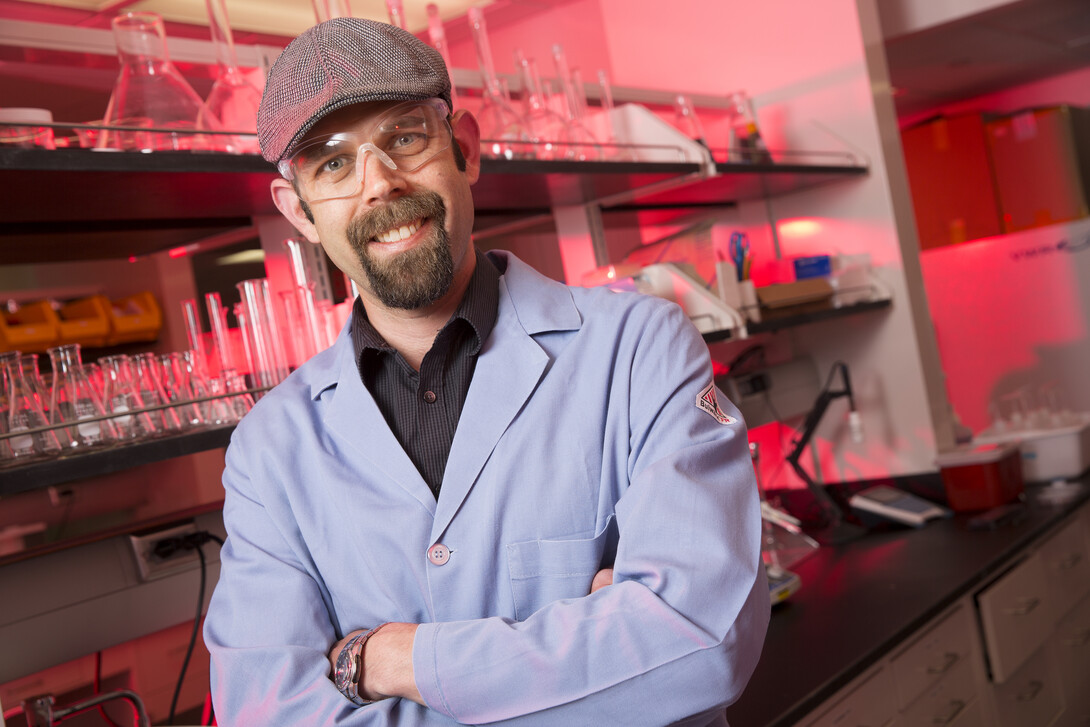
With just a slight stretch of the imagination – and some elastic material – UNL researchers have shown how to create microscopic chemical patterns whose flexibility could extend from the physical to the functional.
In a new study, the authors detail a method for synthesizing hundreds of chemically based shapes in any conceivable pattern on silicone rubber films. The study also outlines multiple potential applications for the technique, which could prove useful in areas ranging from chemistry and circuitry to optics and textiles.
The team’s technique involves oxidizing the material’s surface before attaching amines, ammonia-derived molecules that react with many of the signature atomic groups found in commercially available chemicals.
After “drawing” a honeycomb pattern with the amines, the researchers deposited tiny liquid droplets of a chemical compound onto the silicone and watched as they dutifully filled the hexagonal rows outlined by the pattern.
By stretching the silicone film either before or after depositing the liquid, the researchers also demonstrated the ability to morph the size, shape and density of the chemical pattern and its individual droplets. The team found that the pattern quickly reverted to its original form when the material was relaxed to its natural state.
“Anyone who has written a message on a rubber band is familiar with what happens when you stretch it,” said Stephen Morin, assistant professor of chemistry and the study’s lead author. “In a sense, what we have done here is analogous – but instead of ink from a marker, we have written our message by selectively attaching molecules to form patterns.”
The use of an elastic material affords far more literal and figurative versatility when compared with the more labor-intensive techniques for modifying patterns on rigid surfaces, Morin said.
“While looking through the (research) literature, we were very surprised to see that there was very little to none that actually coupled the mechanical properties of rubber with its surface-chemical properties,” he said. “We are excited by the possibilities. The manipulation of these tiny droplets presents a number of opportunities that haven’t been shown before.”
Having such rapidly reversible control over the chemistry of a surface could point researchers and engineers toward new ways of controlling material properties, behaviors and applications, Morin said.
The ability to easily morph patterns, for example, might reduce the number of masks needed to filter the light exposures that define circuit layouts in computational components. With more research, it could even allow engineers to fabricate designs at scales smaller than they can easily achieve using current methods, Morin said.
“We can use a single mask as a template for our chemical pattern, but by changing the stress in the material relative to the pattern of the mask, we can access different families of patterns,” Morin said. “When you define a pattern (while stretching the film) and then release the material, the features have to get smaller. So you actually can get higher feature density … more simply than by fabricating an entirely new mask.”
Morin said the technique could also be used to organize arrays of liquid micro-lenses. Micro-lens arrays can improve the efficiency of optical detectors to produce high-quality digital images favored in professional photography and medicine.
“Because we can contort the shape of the droplet, we can also easily change the focal length and other properties of the lenses,” Morin said.
The team further showed that it could make droplets evaporate 10 times faster than usual by continuously stretching and relaxing its underlying material. The researchers believe this motion speeds evaporation partly by driving a rapid exchange of molecules between the droplet’s interior and its surface.
This molecular-mixing capacity could make the technique an appealing alternative to a laboratory staple known as the micro-plate, a rigid surface dimpled with small wells that act as miniature test tubes. Chemists often use these plates to mix compounds whose reactions can help characterize the makeup of a chemical or pinpoint markers of disease, among many other uses.
Morin said chemists could potentially employ the droplets as even smaller wells that accelerate reactions and reduce the amount of compound needed for each sample.
“It’s hard to assemble a precise array of really small droplets; there are actually robots that are designed to do this,” he said. “But this is a way of assembling something (similar) by simply stretching and releasing a rubber band.”
The study’s results also suggested that stretching and relaxing such chemically patterned materials could change other properties – including the attraction or repellence to water – that further hint at the technique’s wide-ranging potential.
“It’s going to be interesting to see how the mechanics of soft materials can be coupled with the chemistry on their surfaces to control different types of processes,” Morin said. “If nothing else, this illustrates that something as simple as a rubber band that you played with in elementary school can actually do some pretty interesting things.”
The team’s study appeared in the journal Advanced Functional Materials. Morin authored the study with John Bowen and Jay Taylor, graduate students in chemistry, and Christopher Jurich, a 2015 graduate of Lincoln East High School.
The team received funding from the National Science Foundation, UNL’s Nebraska Center for Materials and Nanoscience, and the University of Nebraska Foundation.








